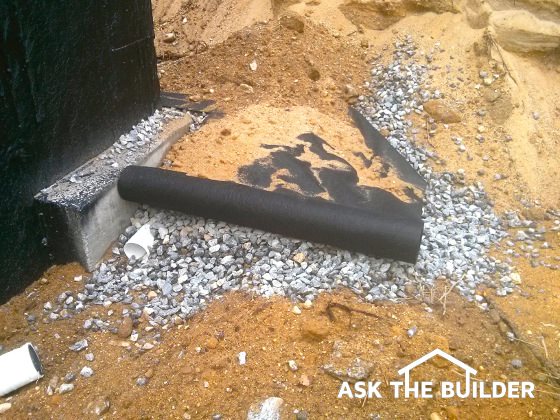Dual Purpose Drain Tile

The builder is doing just about everything right installing this drain tile. Photo Credit: Tim Carter
Drain Tile
I often think about how blessed I am to have worked on older homes long before I started building new homes. Frequently, I would have to excavate next to an old home if I were building a room addition or fixing its old foundation.
Often I would uncover the original drain-tile that rested against the footer just below the foundation wall. The pipe was very unique as it was 12 inch long four inch diameter orange vitrified clay pipe. The individual pieces were just butted up against one another and a piece of thick roofing felt paper was placed over the top of each of the joints.
Rest assured your builder is not going to install your drain tile in this fashion. Newer products and installation methods are available that allow builders to install foundation drainage systems that will work perfectly for many years while providing you will tremendous peace of mind.
What is the purpose of drain tile systems?
But many builders fail to realize that draintile systems can serve two purposes. First and foremost they are supposed to collect water and pipe it to another location where it can be transported away from the foundation. But some new homes have shallow foundations that are just four or five feet below the surface. These can often be found in houses with a walkout basement, those that have a crawlspace and under most attached garages.
How can drain-tiles help in times of a drought?
Draintiles installed next to the footers in these shallow foundations can be used as water injection systems in times of drought. In fact, it is not a bad idea to use draintiles systems in deeper foundations in houses with full basements for the same thing.
The heavy clay soils found under many homes in the Midwest can shrink and swell depending upon how much water they contain. In times of extended drought, some clay soils can shrink to such a degree that the foundation and footer can fall. If the movement is uniform under all of the footers at the same time, then a foundation may not sustain any damage. But this is highly unlikely.
Imagine if your builder were to extend several vertical pipes up from the drain tile system to the grade level around your home. These pipes would connect to the draintile piping with standard tee fittings. Placing a garden hose into the vertical pipe would allow you to add water to the clay soil right where it is most needed.
What is the proper components for a drain tile system?
To maximize the benefits of this water injection system the draintile system needs to be installed with care. If at all possible, try to make sure the piping rests against the footer as opposed to resting on top of the footer. I prefer to have one or two inches of coarse 1 inch or greater diameter washed rounded gravel placed between the soil and the bottom of the drain pipe. If your builder uses plastic draintile that has holes punched in it, these holes should point down not up. If placed up, smaller pieces of gravel can clog the holes. What's more, if the holes are up, it is very hard for the water to get into and out of the pipe.
CLICK or TAP HERE to get FREE quotes from local foundation drainage companies.
The draintile piping should be installed fairly level. It will still drain water just fine if level as it is simply acting as a conduit for water movement. Since water seeks its own level, the water trying to get away from the foundation will flow out of the pipe or towards a basement sump pit with little effort.
Installing the draintile nearly level is the best way when the piping will function as a water injection system. As the water flows into the level piping, it travels rapidly to all parts of the system. This ensures that the clay soils are wetted at or about the same time.
In times of drought, you are simply trying to trick the soil around your footers and foundation. Since the soil can't see the sky, it doesn't know if it is raining or not. This soil simply wants to maintain a fairly constant moisture content so that it doesn't move up or down. Your builder can give you this ability with just a little bit of extra effort and material.
Column NH029